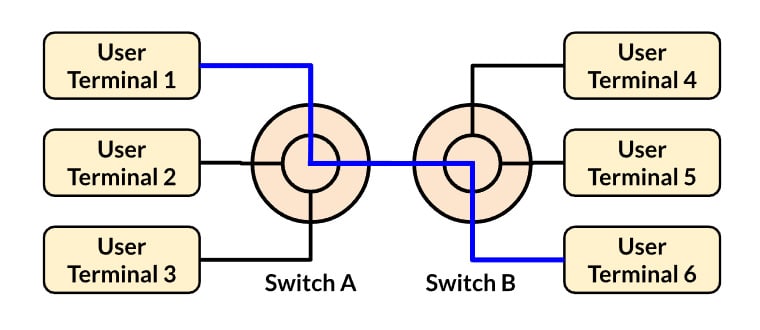All About Circuit Switching Network Communication
Key Takeaways
- Circuit switching network communication enables a specific, dedicated route for communication.
- It is ideal for long-term, uninterrupted communication, as seen in traditional landline telephone systems and optical circuit switching in data centers.
- Unlike packet switching, which divides data into smaller packets, circuit switching maintains a reserved path, providing stable and continuous data transfer.

Diagram of circuit switching network communication connecting user 1 and 6.
Circuit switching network communication involves creating a specific, dedicated route between two points in a network for the entire duration of their interaction. Once connected, this route ensures that the full bandwidth of the channel is available exclusively for this connection. Once the conversation ends, the path is returned to the network's pool. The telephone network is a prime example of this setup.
In this method, a physical path is reserved for a single connection between two endpoints in the network for the duration of the connection. Traditional voice phone services use this technique, preventing any other use until the call concludes. Communication between end devices, or nodes, must be established before they can interact, and the circuit operates as if the nodes were physically linked, similar to an electrical circuit.
About Circuit Switching Network Communication
Ideally, this circuit can not be affected by other users because it remains exclusively reserved until it is released and a new connection is established. Even when no data is transmitted, the channel stays reserved and inaccessible to others.
The benefit of circuit switching is that it allows continuous data transfer without the extra overhead of packet management, maximizing the use of available bandwidth for the connection. However, a downside is its inefficiency, as any unused capacity reserved for a connection cannot be utilized by others on the same network.
Historically, circuit switching was also used for internet connections—as it relied on modem links through the telephone network, which was based on a circuit-switched system. Classic modem dial-up also utilized the same telephone infrastructure for part of its connection path.
Examples of Circuit Switched Network Implementation
|
Network Type |
Description |
|
Optical Mesh Network |
|
|
Circuit Switched Data (CSD) |
|
|
Public Switched Telephone Network (PSTN) |
|
|
B channel of ISDN |
|
|
Datakit |
|
Modern Day Circuit Switching Applications
In modern networking, circuit switching plays a crucial role in applications where a consistent, uninterrupted connection is essential.
Continuous Connections
Circuit switching is ideal for applications requiring long-term, continuous connections, such as long-distance communication. Traditional landline telephone systems exemplify this usage, where a dedicated circuit is established for the entire duration of a call.
Dial-up Network Connections
Although less common today, dial-up internet connections are another example of circuit switching. When computers connect to the internet via dial-up, they use the public switched telephone network. In this scenario, Internet Protocol (IP) data packets are transmitted over a circuit-switched telephone network, providing a dedicated pathway for data exchange.
Optical Circuit Switching
In data centers, optical circuit switching is employed to manage and scale networks to meet increasing bandwidth demands. This technology leverages dedicated optical circuits to handle large volumes of data traffic efficiently, ensuring high-speed and reliable connectivity within data center networks.
Compared with Packet Switching Network Communication
In packet switching, data is divided into smaller packets that travel through the network independently. Unlike circuit switching, there is no dedicated channel; instead, packets share the network with other users' data. The transmission is not continuous but occurs in bursts as each packet is sent separately.
Packet switching does not pre-allocate bandwidth for the entire connection, making it more energy-efficient. However, a downside is that the quality of transmission can suffer due to the potential for packets to be lost or dropped during transit.
Now that you understand the basics of circuit switching network communication, look no further than OrCAD X to design your PCBs enabling this technology. Explore how OrCAD X can streamline your design process and help you harness the full potential of circuit switching for your next project. Learn more about PCB Design and Analysis with OrCAD X.
Leading electronics providers rely on Cadence products to optimize power, space, and energy needs for a wide variety of market applications. To learn more about our innovative solutions, talk to our team of experts or subscribe to our YouTube channel.